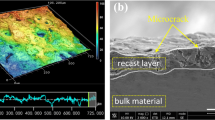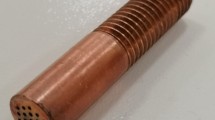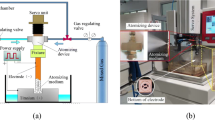Abstract
Due to its exceptional performance, the Ti6Al4V alloy finds extensive use in aviation, biomedical, and petrochemical sectors. Nonetheless, its limited machinability and subpar wear resistance have hindered its widespread application. Therefore, this study underlooks a novel approach by employing nitrogen (N2) gas–assisted electrical discharge machining (NA-EDM) to machine Ti6Al4V. In this context, N2 gas serves a dual purpose. On the one hand, the flow of N2 has a beneficial impact on enhancing the surface properties of the workpiece. On the other hand, N2 reacts with titanium (Ti) to create titanium nitride (TiN), enhancing the component’s performance. Also, this study focuses on investigating how peak current, pulse-on time, electrode rotation speed, and gas pressure influence various aspects, including surface morphology, surface roughness, the microstructure of the recast layer, the microhardness of the recast layer, the thickness of the recast layer, and material removal rate (MRR). Experimental findings show that the NA-EDM process results in a smoother surface morphology, a uniform recast layer, and a reduced MRR. The microhardness in NA-EDM exceeds that of EDM by 42.1%, attributed to the formation of TiN and martensite. Ra is decreased by 21.2% compared to EDM. This study offers novel insights into machining Ti6Al4V alloy, opening up possibilities for broader-scale applications.











Similar content being viewed by others
Data availability
All data that support the findings of this study are included in this manuscript.
References
Kumar S, Verma A (2020) Surface modification during electrical discharge machining process – a review. Mater Today: Proc 46:5228–5232. https://doi.org/10.1016/j.matpr.2020.08.596
Bangash MK, Casalegno V, Das AK, Ambrois SDLPD, Ferraris M (2020) Surface machining of Ti-6Al-4V by means of micro-electrical discharging to improve adhesive joining. J Mater Process Technol 286:116813. https://doi.org/10.1016/j.jmatprotec.2020.116813
Selvarajan L, Rajavel R, Venkataramanan K, Srinivasan VP (2023) Experimental investigation on surface morphology and recasting layer of Si3N4-TiN composites machined by die-sinking and rotary EDM. Cream Int 49(5):8487–8501. https://doi.org/10.1016/j.ceramint.2022.11.011
Li L, Li ZY, Wei XT, Cheng X (2015) Machining characteristics of Inconel 718 by sinking-EDM and wire-EDM. Mater Manuf Processes 30(8):968–973. https://doi.org/10.1080/10426914.2014.973579
Kumar SS, Varol T, Canakci A, Kumaran T, Uthaykumar M (2021) A review on the performance of the materials by surface modification through EDM. Int J Lightweight Mater Manuf 4(1):127–144. https://doi.org/10.1016/j.ijlmm.2020.08.002
Dhakar K, Chaudhary K, Dvivedi A, Bembalge O (2019) An environment-friendly and sustainable machining method: near-dry EDM. Mater Manuf Processes 34:1307–1315. https://doi.org/10.1080/10426914.2019.1643471
Wang XL, Shen Y (2019) High-speed EDM milling with in-gas and outside-liquid electrode flushing techniques. Int J Adv Manuf Technol 104(1):3191–3198. https://doi.org/10.1007/s00170-019-04242-8
Kong LL, Liu ZD, Qiu MB, Wang WZ, Han YX, Bai SK (2019) Machining characteristics of submersed gas-flushing electrical discharge machining of Ti6Al4V alloy. J Manuf Process 41:188–196. https://doi.org/10.1016/j.jmapro.2019.02.023
Beravala H, Pandey PM (2021) Experimental investigations to evaluate the surface integrity in the magnetic field and air/gas-assisted EDM. J Braz Soc Mech Sci Eng 43(4):213. https://doi.org/10.1007/s40430-021-02929-2
Takezawa H, Hayashi S (2018) Effect of mixing gas for machining surface property of micro-bubble entrained EDM. Procedia CIRP 68:298–302. https://doi.org/10.1016/j.procir.2017.12.067
Takezawa H, Suzuki K, Mohri N (2015) Characteristics of electrical discharge machining in a working fluid mixed with micro-bubbles. Key Eng Mater 625:554–558. https://doi.org/10.4028/www.scientific.net/KEM.625.554
Sharma D, Mohanty S, Das AK (2020) Surface modification of titanium alloy using hBN powder mixed dielectric through micro-electric discharge machining. Surf Coat Technol 381:125157. https://doi.org/10.1016/j.surfcoat.2019.125157
Dwivedi AP, Choudhury SK (2016) Effect of tool rotation on MRR, TWR, and surface integrity of AISI-D3 steel using the rotary EDM process. Mater Manuf Processes 31:1844–1852. https://doi.org/10.1080/10426914.2016.1140198
Muthuramalingam T, Mohan B (2015) A review on influence of electrical process parameters in EDM process. Arch Civ Mech Eng 15(1):87–94. https://doi.org/10.1016/j.acme.2014.02.009
Kong LL, Liu ZD, Bai SK, Qiu MB, Han YX (2019) Investigation of the controllable characteristics of electrical discharge ablation of Ti6Al4V. Int J Adv Manuf Technol 105(5):1645–1654. https://doi.org/10.1007/s00170-019-04399-2
Hasçalık A, Çaydaş U (2007) Electrical discharge machining of titanium alloy (Ti-6Al-4V). Appl Surf Sci 253:9007–9016. https://doi.org/10.1016/j.apsusc.2007.05.031
Aliakbari E, Baseri H (2012) Optimization of machining parameters in rotary EDM process by using the Taguchi method. Int J Adv Manuf Technol 62:1041–1053. https://doi.org/10.1007/s00170-011-3862-9
Semiatin SL, Seetharaman V, Weiss I (1997) The thermomechanical processing of alpha/beta titanium alloys. JOM 49(6):33–68. https://doi.org/10.1007/bf02914711
Leyens C, Peters M (2003) Titanium and titanium alloys, fundamental and applications. Wiley-VCH GmbH & Co. KGaA
Strásky J, Janeček M, Harcuba P, Bukovina M, Wagner L (2011) The effect of microstructure on fatigue performance of Ti–6Al–4V alloy after EDM surface treatment for application in orthopaedics. J Mech Behav Biomed Mater 4(8):1955–1962. https://doi.org/10.1016/j.jmbbm.2011.06.012
Tang JJ, Yang XD (2018) Simulation investigation of thermal phase transformation and residual stress in single pulse EDM of Ti-6Al-4V. J Phys D: Appl Phys 51(13):135308. https://doi.org/10.1088/1361-6463/aab1a8
Schumacher BM (1990) About the role of debris in the gap during electrical discharge machining. CIRP – Annals Manuf Technol 39(1):197–199. https://doi.org/10.1016/S0007-8506(07)61034-8
Luo YF (1997) The dependence of interspace discharge transitivity upon the gap debris in precision electro discharge machining. J Mater Process Technol 68:121–131. https://doi.org/10.1016/S0924-0136(96)00019-2
Gatto A, Bassoli E, Denti L, Iuliano L (2013) Bridges of debris in the EDD process: going beyond the thermo-electrical model. J Mater Process Technol 213(3):349–360. https://doi.org/10.1016/j.jmatprotec.2012.10.020
Funding
This work was supported by the Natural Science Foundation of Shandong Province (ZR2018MEE025).
Author information
Authors and Affiliations
Contributions
All authors contributed to the study conception and design. Material preparation, data collection, and analysis were performed by Zaichao Liu, Xianfu Liu, Jianbing Meng, and Xue Bai. The first draft of the manuscript was written by Zaichao Liu, and all authors commented on previous versions of the manuscript. All authors read and approved the final manuscript.
Corresponding author
Ethics declarations
Conflict of interest
The authors declare no competing interests.
Additional information
Publisher’s note
Springer Nature remains neutral with regard to jurisdictional claims in published maps and institutional affiliations.
Rights and permissions
Springer Nature or its licensor (e.g. a society or other partner) holds exclusive rights to this article under a publishing agreement with the author(s) or other rightsholder(s); author self-archiving of the accepted manuscript version of this article is solely governed by the terms of such publishing agreement and applicable law.
About this article
Cite this article
Liu, Z., Li, L., Yan, J. et al. Electrical discharge machining of Ti6Al4V alloy with nitrogen gas assistance. Int J Adv Manuf Technol 129, 2609–2620 (2023). https://doi.org/10.1007/s00170-023-12462-2
Received:
Accepted:
Published:
Issue Date:
DOI: https://doi.org/10.1007/s00170-023-12462-2




